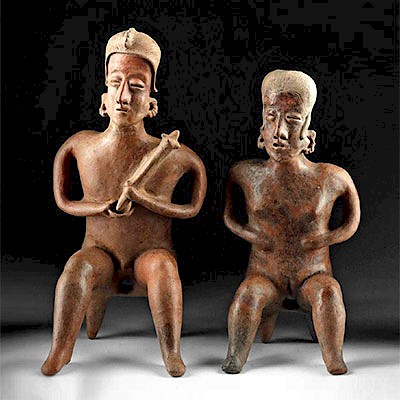Stunning Jamacoaque Pottery Seated Figure
Lot 124f
About Seller
Artemis Fine Arts
686 S Taylor Ave, Ste 106
Louisville, CO 80027
United States
Selling antiquities, ancient and ethnographic art online since 1993, Artemis Gallery specializes in Classical Antiquities (Egyptian, Greek, Roman, Near Eastern), Asian, Pre-Columbian, African / Tribal / Oceanographic art. Our extensive inventory includes pottery, stone, metal, wood, glass and textil...Read more
Estimate:
$2,000 - $3,000
Absentee vs Live bid
Two ways to bid:
- Leave a max absentee bid and the platform will bid on your behalf up to your maximum bid during the live auction.
- Bid live during the auction and your bids will be submitted real-time to the auctioneer.
Bid Increments
| Price | Bid Increment |
|---|---|
| $0 | $25 |
| $300 | $50 |
| $1,000 | $100 |
| $2,000 | $250 |
| $5,000 | $500 |
| $10,000 | $1,000 |
| $20,000 | $2,500 |
| $50,000 | $5,000 |
| $100,000 | $10,000 |
| $200,000 | $20,000 |
About Auction
By Artemis Fine Arts
May 23, 2019
Set Reminder
2019-05-23 10:00:00
2019-05-23 10:00:00
America/New_York
Bidsquare
Bidsquare : Exceptional Day 2 Ethnographic Tribal Fossils
https://www.bidsquare.com/auctions/artemis-gallery/exceptional-day-2-ethnographic-tribal-fossils-4136
Day 2 of an important 2-day auction featuring exceptional ethnographic art from around the world. Today's sale will feature Pre-Columbian from the ancient americas, Native American, African / Tribal, Oceanic, Spanish Colonial, and incredible Fossils. Artemis Fine Arts info@artemisfinearts.com
Day 2 of an important 2-day auction featuring exceptional ethnographic art from around the world. Today's sale will feature Pre-Columbian from the ancient americas, Native American, African / Tribal, Oceanic, Spanish Colonial, and incredible Fossils. Artemis Fine Arts info@artemisfinearts.com
- Lot Description
Pre-Columbian, Ecuador, Manabi Province, Jamacoaque (Jama Coaque or Jama-Coaque), ca. 500 CE. A hollow mold-made terracotta female figure who sits with four birds perched upon her arms and her hands placed upon two percussive drums. She is highly decorated with an elaborate beaded necklace of turquoise hues and multiple yellow strands, multiple armlets and bracelets adorned by turquoise blue and yellow hues, large ear ornaments incised so as to resemble shells, an enormous yellow nose ring, pointed blue labret flanked by four hemispheric face piercings - as well as a striking headdress and coiffure - the headdress comprised of 3 raised hemispheric sections (with twin pointed lobes of hair emerging from the outer 2) - that are incised with zigzag and ray motifs and present traces of turquoise blue pigment, over a plain yellow caplike section. Liberal remains of aqua blue, golden yellow, and green pigment adorn the figure and her accoutrements. Size: 8.375" W x 10.5" H (21.3 cm x 26.7 cm)
It is clear that the Jama-Coaque artists were a sophisticated lot who could create finely modeled sculpture as well as various textiles adorned with imaginative ornamentation, quite evident in the workmanship required to create the elaborate regalia of this seated figure's highly decorated state. The Precolumbian worship of sky animals, here referenced by the birds, stemmed from their belief that these winged creatures served as messengers between man and his deities.
Provenance: Morton Dimondstein, Los Angeles; Acquired from the above in the 1970's and early 1980's; ex John Rich collection, Beverly Hills CA. John was a notable Hollywood producer/director.
All items legal to buy/sell under U.S. Statute covering cultural patrimony Code 2600, CHAPTER 14, and are guaranteed to be as described or your money back.
A Certificate of Authenticity will accompany all winning bids.
We ship worldwide and handle all shipping in-house for your convenience.
#145916Repaired from multiple pieces with restoration over the break lines. Bird on right hand has been restored. Liberal amounts of original pigment save areas of restoration. Nice manganese deposits.Condition
- Shipping Info
-
All shipping is handled in-house for your convenience. Your invoice from Artemis Gallery will include shipping calculation instructions. If in doubt, please inquire BEFORE bidding for estimated shipping costs for individual items.
-
- Buyer's Premium



 EUR
EUR CAD
CAD AUD
AUD GBP
GBP MXN
MXN HKD
HKD CNY
CNY MYR
MYR SEK
SEK SGD
SGD CHF
CHF THB
THB















